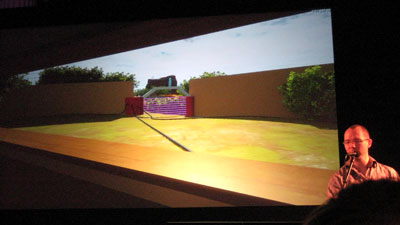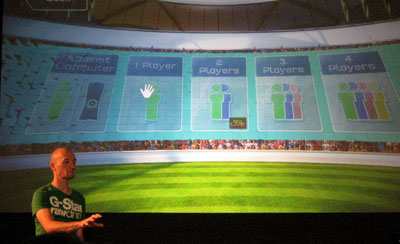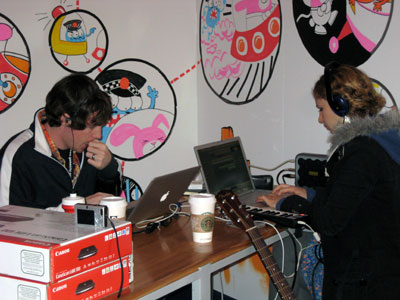I have just about recovered from the annual whirlwind event that is GameCity. I’d like to cover the highlights of this year’s games culture festival.
Guardian Breakfasts
Keith Stuart from the Guardian kicked off each morning with a discussion around video games, looking at the new technology, the most important games so far, emotional impact of games and the possible future of gaming. Despite my sleep deprived state these were so good that I still managed to get into Nottingham city centre bright and early and a big thanks to Broadway cinema for putting on a slap up breakfast to help me get started for the day ahead. Unlike me Keith however was lucid and spoke intelligently about each subject, and had a changing panel of guests from speakers at the festival to give their two pence worth.
Limbo

Often in games that move me the audio will affect me, even if I’m often unaware of the impact that it is having as it adds to the game without distracting from the game-play. Limbo is just such a game, and Martin Stig Anderson did an amazing job of the audio for the game. His discussion and demonstration of the audio work for Limbo was really enlightening. He detailed how he had created the sounds, rerecording them through wire in order to distort them until the source was no longer decipherable. As Anderson spoke about how the transitions were handled in the platform game, in order to give areas of the game an identity and atmosphere, it really opened my mind to the complex possibilities of audio in games as the usually linear nature of music is turned on it’s head if placed in the context of a nonlinear game where the user controls the journey both in time and space. In Limbo Anderson used the environment of the game to create the soundtrack, rather than overlaying the game with a piece of music.
He also spoke about how audio offers us the most “temporal nuances” compared to our other senses, which tied Jonathan Blow’s earlier talk in the day about Braid and learning the rhythm of platform games, such as Super Meat Boy in order to be able to play them. We can learn to play some games by ear.
James Hannigan
Photo of the James Hannigan event at GameCity kindly permitted by zo-ii
This event was astounding and a fine example of what GameCity do amazingly well and you experience no where else; the convergence of cultures in a way that is both theatrical and emotive. Last year we saw Robin Hunicke perform Flower in a shopping centre complete with falling petals. This year we had Pinewood Choir in St Mary’s, the oldest church in Nottingham, performing soundtracks from games such as and Command and Conquer: Red Alert 3, Warhammer and Harry Potter the Deathly Hallows, complete with live owls. There is something profound about hearing an talented choir perform in the reverberating acoustics of an old gothic church, but when the music they are singing takes to back to a moment in a game they combine in a way that gives a sense of grandeur to an often underrated part of the gaming experience.
Spy Party
Chris Hecker played his new game Spy Party against a large crowd and beat us all, but it doesn’t end there, I managed to get a hands on with the game later in the GameCity lounge and it was really great fun to play. Spy Party is a bit like a reversed Turing machine, it’s 1vs1 and you have to try and perform several spy acts before time runs out and without the other player spotting you in crowded room full of AI. In order to succeed you have to play like the other AI characters, any uncharacteristic behaviour and your opponent can snipe the suspected spy and end the game.
Hecker talked about asymmetrical game-play, such as Left for Dead, where you have to learn how to play the game, as different tactics are required depending which side you are on. He spoke about games of perception, deception and performance and that often you were required to these things synchronously, but by allowing a player to concentrate on either deception or perception enabled him to make the game more difficult, completely focusing on player skill, i.e. you have to get better at playing the game rather than upgrading an avatar. A big challenge to playing this game is finding people at the same level to play against, since even playing a few times gives you an distinct advantage, but it was great fun to play and I’m looking forward to playing it again.
Jonathan Blow gave two talks, one about his successful indie game Braid and a second one about his upcoming game Witness.
Braid
Blow showed us early prototypes for Braid and discussed some key dynamics for designing a platform game, such as having a rectangular game character, like Mario or Super Meat Boy, as a necessity to make it easier to judge your centre. It was interesting to explore using the time game dynamic within the confines of a platform game, one of the oldest and most familiar types of game. It is this familiarity with how we expect the game to work, that allows Blow to make challenging time based puzzles that require us to learn a new way of playing. But because they are difficult he spoke about trying to remove distractions, such as sticking with the familiar setting of blue sky and green grass. Subtly giving us information on interactivity, by set pieces having more detail if the are interactive, or less if the are background set.
The art work for Braid is very beautiful and he pointed out that there were individual icons for all the beasts on the level as they died, rather than the same sprite used repeatedly. He also demonstrated that when time slowed down you could see the beasts get upset when they were killed, so it felt like he was trying to create a degree of empathy for the player and he wanted you to question your wanton killing of these beasts, whilst also making it necessary to kill some in order to progress through the game, again subverting the familiar platform game.
Witness

View through the window early on in Witness
Later in the week Blow talked about his new game, but less about what he was creating and more about how the game introduces itself to the player. This was fascinating to me on a personal level as I’m really interested in usability and how we learn to understand software.
Blow talked about how often games put vast amounts of resources into creating really rich environments, such as Assassins Creed 2 and Fable 2, but how they never fulfill their potential as rather than enabling the player to observe and learn from their environment they are instead forced into more linear game play, by either a radar of tasks or a golden path to follow. We never need learn to observe the dog in Fable 2 when he finds treasure as an icon helpfully pops up over it’s head telling you to dig.
Blows demonstration clear showed a build up of information, starting with the very minimum, just arrow controls to move you forward to a door. The door had a very simple action to perform to open it and already we have learnt how to move about and how to interact with the puzzles in the game. It was the very clever way he built upon existing knowledge, not assuming a level of understanding, but offering small challenges built upon previous experience that enables the learner to understand and learn what they need to do next.
In addition to this it was very clear that despite being set in an open world he was very conscious of what you could see as certain points in the game, in order to give you a sense of direction and purpose. After passing through the first door, you can see a second door and through a window which offers a limited view of the future puzzles, so you get a sense of where you need to go. Also when in the open world he used the height of buildings and perspective in a way to help guide you over short term and longer term goals. Although it seemed like it was holding the players hand a lot at the beginning, by presenting very simple puzzles, building on this fundamental familiarity and understanding of the game enables Blow to make the puzzles much more complicated as the game develops, although we didn’t see enough to see how he will exploit this.
Kinect

Nick Burton shows off Microsoft’s Kinect
Rare are working on Kinect Sports, a launch title for Microsoft’s Kinect, which Nick Buron demonstrated at GameCity. He showed off a bit of the under the hood, in terms of what Kinect can actually do and one thing that became clear was how Kinect demands a in depth understanding of biometrics, in order to really understand what movement a body is making. He also spoke about the challenges of working creating a Kinect game that was accessible both the casual gamer market and children as well as the hardcore gamer who wants more of a challenge. Its obvious they have learnt some lessons from both the great successes and the failures of the Wii.
As with the any new kind of interface both the developers and the audience need to learn to understand about how to interact. As with the Wii and Move before it, sports games offer easy access to these new types of motion based interface, because they offer already understood affordance both for the user and the developer. In my own mind the first generation of games don’t really offer us anything particularly new, but once we all get more familiar with the interface, Kinect seems capable of much more subtle input and hopefully we will find new kinds of games that explore that potential.
Saltsman and Mayes

Working on Ideasbucket
As part of the festival there was a project to create a game. Firstly ideas were submitted by the public, often involving bright crayons and gratuitous amounts glitter. Then Adam Saltsman, creator of Cananbalt and Rebecca Mayes, the singing reviewer of games, worked together to create a game in a single day. It was interesting to see how they worked together and you could see both the code creation and the the music develop as part of the organic process of creating a game. Find out more.
Pac-Notts

The streets of Nottingham became PacMan’s maze
Turned the streets of Nottingham into a PacMan maze, with the help of a handful of laptops and some mobile phones and ten willing volunteers. Half the players are the game characters out on the streets of Nottingham, the other half are located at the base with laptops, one laptop and partner per game character. The ghosts work as a team trying to find PacMan and catch him, with the players reporting any sightings to their partners via mobile phone, who in turn co-ordinate the ghost tactics and input ghost locations on the map. One pair work as PacMan, they can use power pills at the corners of the map to turn the tables or try and avoid ghosts, the person with the laptop updates PacMan on the location of the ghosts, which they can see on the laptop.
I managed to play three games, and I have to say that as much as running through the streets of Nottingham, midday on a Saturday at half-term, wearing a giant Blinky shirt sounds like a nightmare it was actually great fun. I even managed to catch PacMan! Check out were PacMan will be next on their website.
Laser maze
Ever wished you were in any of those cat burglar, heist or spy films with laser security? Nottinghack made it yours for the taking by put on a laser maze at Lee Rosy’s Tea Shop, where you got to act out your fantasies by navigating the maze and defusing the bomb. Were you Cathrine Zeta Jones or James Bond? Great fun.
I’d just like to finish off by thanking all the team that bring us GameCity, it is still massively overlooked as a festival and is unique in the way it brings together the industry and the customers and in the diversity of the events it runs, there really is something for everyone. If I were to make any criticism this year it would have been the lack of representation of women in the industry, but that is not unique to this event. The thing that really makes the festival for me is the people, I have consistently met interesting and friendly people over the five years the festival has been running. Thanks everyone, see you next year.

No mention of James playing on the stage at Kinect? hehe! 🙂 he was such a star!
Nice review of the week, reminds me I need to write up my thoughts, but I’ve nothing compared to this!
Comments are closed.